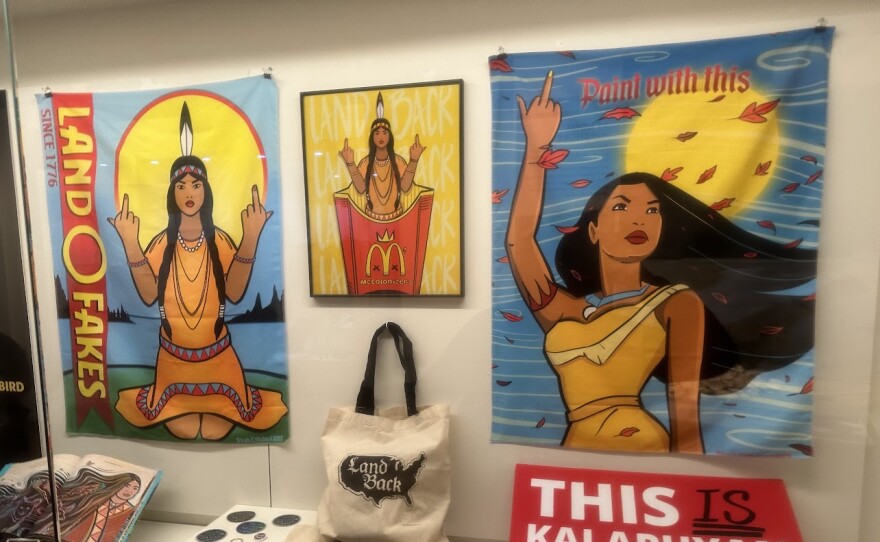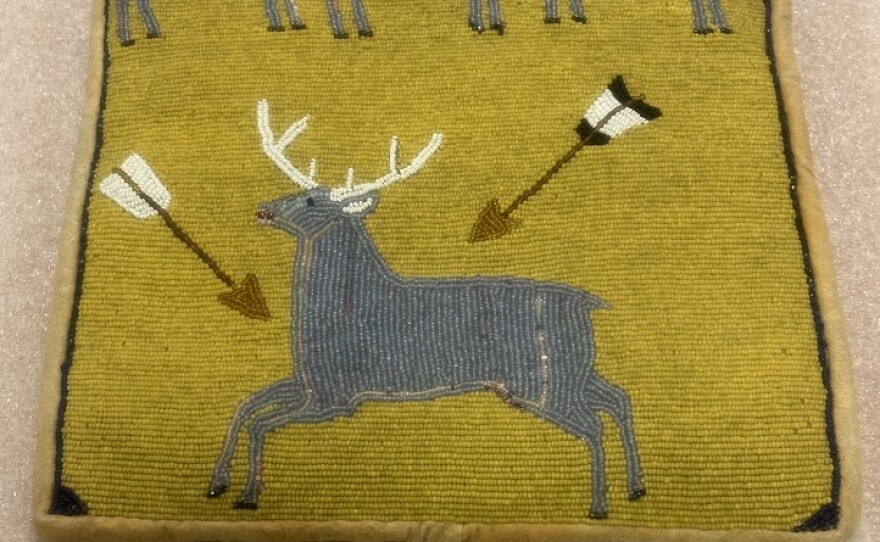Historically, museums across the U.S. have taken a detached, scholarly, and archaic view of Native Americans. But over the past decade especially, there’s been a push by Native advocates and their supporters to “decolonize” -- or alternately, “Indigenize” – these institutions, including here in Oregon.
All in the family
Near the pow-wow grounds in Grand Ronde recently, tribal member Stephanie Craig sorted items in the back of her vehicle, including several that are more than a century old. She’s a traditional basket weaver, who had just returned from a presentation at the Museum of Natural and Cultural History in Eugene, where she also studied while working on her B.A. in Anthropology of the Pacific Northwest.
“This is my daughter’s maple bark ceremonial skirt. It’s got white buckskin hem and abalone shells on it,” said Craig, presenting the garment. She said her daughter will wear this for ceremonies held either in a longhouse or plank house.
She then shook an intricate baby rattle with willow root on the handle.
“We use the willow on the handle part because it has natural aspirin in it,” explained Craig. “So when the baby’s teething, they get aspirin for their gums.”
Other items included a basket made by her great-great-great grandmother, Martha Jean Sands, which is nearly 110 years old. Her wedding veil features old Chinese coins, abalone, dentalium, and brass and glass beads.
You can call these items “beautiful” or “practical.”
Just don’t call them “artifacts."
“I hope people will start looking at things more as belongings,” explained Craig, gingerly putting the veil back into its container. “You don’t call your family’s items 'artifacts' or 'relics.' They're family heirlooms, and that’s the same for us.”
Craig co-wrote an article with Yoli Ngandali, a member of the Ngbaka Tribe from the Democratic Republic of the Congo, for the Society for American Archaeology’s latest journal. The piece challenges institutions to rethink centuries-old terms, practices, and philosophy when it comes to handling Indigenous items. This includes taking them out from behind the glass or curator’s drawer, to serve their function.
“It’s important for these belongings to still be handled and touched, because the exchange of energy,” Craig told KLCC. “They once were living and we’re living. And in order to keep the energy flowing and the good energy going, they need to be touched. They need to be appreciated.”
Centuries of plunder
Over the past 200 years, institutions including colleges, universities, and churches pillaged burial sites or confiscated items from Native American communities for their collections. Between 1860 and 1873, the Smithsonian Institution alone accrued more than 13,000 items. Many curators assumed they were gathering relics from a dying people.

That narrative is being increasingly challenged.
“We’re still here, we’re still creating, and continuing with our culture through our artistry,” said Phil Cash Cash, as he handled several old garments and pieces of jewelry at the High Desert Museum in Bend.
Cash Cash also played one of two handcrafted flutes he made for a recent exhibit, titled Creations of Spirit. The focus was on contemporary artists, who carry on traditional culture.
“When I play the flute, I play it for our land, in our Earth, rather than for humans," he said. "And so it’s almost like a prayer that goes out to the world.”
Cash Cash is of Nez Perce and Cayuse heritage, and has worked as a consultant with the High Desert Museum for five years. In a lower level reserved for collections, he explained the significance of several Native items which included a woman’s choker made of dentalium shells and dark blue beads, with a unique adornment.
“This pair of baby moccasins, she’d wear this in hopes that she would bear children later in life,” he said, noting that the miniature foot coverings would have likely been worn behind the neck and under the woman’s hair, to keep her wishes private.
With a man’s beaded vest, Cash Cash noted a number of elements that gave it a special meaning.
“Here you see the deer and the foliage and flowers on the base, implying there’s Earth and a growth in the deer there on the earthly plane,” he said, before gesturing to the upper half. “Above it is flying a golden eagle, and even higher is a star and crescent moon. So if you can imagine three different realms being connected, the earthly realm, the realm of air, and then the realm of stars or light forms, there’s all this deeper significance on linking to the light. We are part of this bigger realm of life and are contained.”
A shift towards inclusion and collaboration
For many years, non-Indian curators were either denied insights like these by untrusting Natives, or ignored them out of arrogance. But with more Native Americans becoming involved with interpreting their culture, this traditional knowledge has been gaining ground in institutions.
“There’s been a real shift in the entire field to incorporate Indigenous voices and perspectives. And it’s long overdue,” said Dana Whitelaw, executive director of the High Desert Museum. She told KLCC that her museum doesn’t have any Native American staff, but consults with about ten advisors from regional tribes on projects.
Whitelaw says a collaborative renovation is being planned for By Hand Through Memory, an exhibit that opened in 1999 and was curated by Vivian Adams of the Yakama Nation. This updated exhibit will depend on past outreach and trust-building with tribal partners.
“We started working with the museum at Warm Springs in 2017, sharing meals and visiting exhibitions together,” recalled Whitelaw. “And there are awkward moments and missteps, but with that relationship building comes trust, and colleagues and partnerships.”
Hits and misses
The National Museum of the American Indian Act of 1989, and the Native American Graves and Repatriation Act (NAGPRA) of 1990 have spurred much of this reform. But in the 30 years since these landmark regulations were enacted, many institutions have not followed through on returning stolen items and remains to tribes. A January 2023 ProPublica report found that there were over 110,000 remains that had yet to be returned by many prominent museums.
Other places criticized by Native Americans include the Plimoth Patuxet Museums, which was supposed to be a bicultural, re-enactment program that balanced the early story of early European settlers and the Indigenous peoples. But last year the Wampanoag community blasted the “tone deaf” handling of the presentation, and called for a boycott.
And Chicago’s famed Field Museum recently unveiled an overhaul of its interpretive displays and programming, which seeks to address decades of inaccurate and Eurocentric information.
At the Museum of Natural and Cultural History in Eugene, a multimedia station lets visitors watch videos. One shows members of the Coos, Lower Umpqua, and Siuslaw Indians paddling their traditional canoes.
“We call ours ‘deer nose’ canoes, with the tail, so it, it looks like a deer coming down,” explains a man in the video.
Ann Craig is director of public programs at the MNCH. She said an earlier version of this exhibit area was done with tribes.
“And at the time, that was really progressive," she said. "But the hall had previously been all sepia tone. So even if there was a historic image and a contemporary image, they were both sepia tone. So it made Indigenous people in the exhibit all look historical.”
The museum’s executive director, Todd Braje, says they’ve been receptive to tribal concerns. For example in 2014, some items were removed that a Cow Creek member deemed inappropriate for display.
Braje says they also strive to keep Natives in the present tense.
“Rather than museums being set up to be sort of mausoleums where we put artifacts from the deep past into a case and we talk about deep history, what you see in this case, are weavings that are thousands of years old, next to contemporary baskets," he said. "It shows this connection between present people and deep tradition in Oregon.”
Looking ahead
Some institutions like the Five Oaks Museum in Portland have incorporated exhibits curated by Native Americans, or have included them to consult on programming. Native advocates say there’s still room for improvement, both locally and afar. While the Smithsonian says it’s repatriated roughly 5,000 remains since 1989, it still has about 2,000 more in its collection.

Grand Ronde tribal member Stephanie Craig said that she’d like to address issues overseas, as many tribal materials were sent back to Europe by missionaries, traders, and explorers.
“I would love to go to the British Museum and look at everything that they have from Oregon and Northern California and Southern Washington,” said Craig. “Because a lot of things are misidentified. It's not until you look at that the actual belonging itself and doing research where you can really determine where the belonging comes from.”
While doors and ears seem more open than ever to Indigenous perspectives, Craig said getting the time and money to travel over the pond is the biggest barrier. But if she can, she’d like to study the items on hand and also explore how complete their reputed inventory is.



























